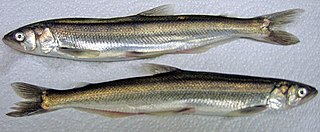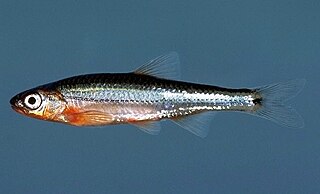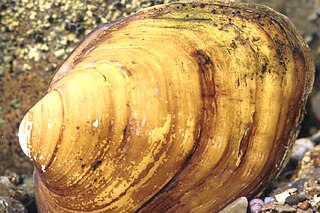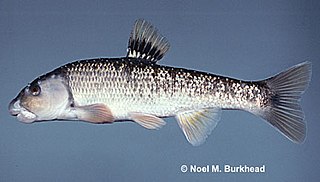
The eulachon, or the candlefish, is a small anadromous species of smelt that spawns in some of the major river systems along the Pacific coast of North America from northern California to Alaska.

The Apache trout or Arizona trout, is a species of freshwater fish in the salmon family of order Salmoniformes. It is one of the Pacific trouts.

The Pacific razor clam, Siliqua patula, is a species of large marine bivalve mollusc in the family Pharidae.
The conservation status of a group of organisms indicates whether the group still exists and how likely the group is to become extinct in the near future. Many factors are taken into account when assessing conservation status: not simply the number of individuals remaining, but the overall increase or decrease in the population over time, breeding success rates, and known threats. Various systems of conservation status are in use at international, multi-country, national and local levels, as well as for consumer use such as sustainable seafood advisory lists and certification. The two international systems are by the International Union for Conservation of Nature (IUCN) and The Convention on International Trade in Endangered Species of Wild Fauna and Flora (CITES).

Echinacea tennesseensis, also known as the Tennessee coneflower or Tennessee purple coneflower, is a flowering plant in the family Asteraceae, endemic to the cedar glades of the central portion of the U.S. state of Tennessee.

The Tennessee shiner is a species of fish in the family Cyprinidae, the carps and minnows. It is native to the southeastern United States.

The oldfield mouse, oldfield deermouse or beach mouse is a nocturnal species of rodent in the family Cricetidae that primarily eats seeds. It lives in holes throughout the Southeastern United States in beaches and sandy fields. Predators to these mice include birds and mammals. In 2016, these mice were in the least concern category on the IUCN Red List with certain subspecies classified as extinct, critically endangered, endangered or near threatened.

The blackside dace is a species of ray-finned fish in the family Cyprinidae. It is endemic to the Cumberland River drainage in Kentucky and Tennessee as well as the Powell River drainage in Virginia in the United States. It is a federally listed threatened species.

The trispot darter is a species of freshwater ray-finned fish, a darter from the subfamily Etheostomatinae, part of the family Percidae, which also contains the perches, ruffes and pikeperches. It is endemic to northern Georgia and southern Tennessee in the United States, where it occurs in the Conasauga River and its tributaries and historically in the Alabama River system. It requires two interconnecting habitats; outside the breeding season it occupies the peripheral zones of the main river, with slow-moving water and silt gravel substrates with vegetation cover; during the breeding season it moves to warmer water with a clay-bottomed substrate with much vegetation. The population of this fish is declining due to loss of suitable habitat because of stream impoundment and land development. The International Union for Conservation of Nature has assessed its conservation status as being "vulnerable".

Fusconaia cuneolus, the fine-rayed pigtoe pearly mussel or fine-rayed pigtoe, is a species of bivalve in the family Unionidae. It is native to Tennessee, Alabama, and Virginia in the United States, in each of which its population has declined severely. It is a federally listed endangered species of the United States.

Plethobasus cyphyus, the sheepnose mussel, is a species of freshwater mussel, an aquatic bivalve mollusk in the family Unionidae, the river mussels.

Pleurobema oviforme, the Tennessee clubshell, is a species of freshwater mussel in the family Unionidae, the river mussels. It is native to the eastern United States, where it occurs in Alabama, Kentucky, North Carolina, Tennessee, and Virginia. It also previously occurred in Mississippi.
Robert C. Cashner is an American ichthyologist and retired academic administrator.
The central stoneroller, or Ohio stoneroller, is a fish in the family Cyprinidae endemic to North America.

The largescale stoneroller is a fish in the family Cyprinidae native to the eastern United States.

Campostoma, the stonerollers, is a genus of cyprinid fish found in North America. There are currently six species recognized for this genus.
The bluefin stoneroller is a fish in the family Cyprinidae endemic to the southeastern United States.
The highland stoneroller is a species of fish in the family Cyprinidae. It is endemic to the United States where it occurs in certain drainages of the Red, Ouachita, and lower Arkansas river basins from eastern Oklahoma to central Arkansas.












